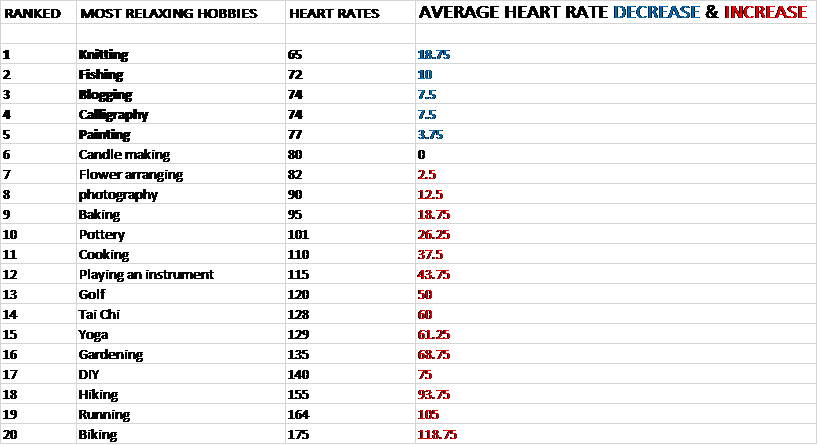Fitbit Test Reveals the MOST Relaxing Hobby You Should Take Up This Year
Fitbit Test Reveals the MOST Relaxing Hobby You Should Take Up This Year
• The most relaxing hobby with the lowest measured heart rate is knitting – with 65 beats per minute it was voted by 93% of Brits as the most relaxing.
• Knitting can lower your resting heart rate to 18.75% whereas, ‘pedal to the metal’ hobby, biking can increase it by up to 118.75%!
• In last place is cycling with 175 beats per minute and only 29% of people saying it is the most relaxing hobby.
• According to Brits and the Fitbit test, the top five most relaxing hobbies to take up this year are: knitting, fishing, blogging, calligraphy, and painting.
As Brits get back into the office and life begins to return to ‘normal’, maintaining a work-life balance can be stressful. As a result, diys.com examined the hobbies that most reduce our stress levels by surveying 2,379 people.
Thereafter, diys.com conducted a Fitbit test among 357 participants, aged 20-30 years old to find out if the most relaxing hobby and most loved hobby complement one another. The participants were asked to wear a Fitbit while completing 20 popular hobbies determined from the survey.
The data was collected over several weeks and diys.com can now reveal which soothing tasks most relax our heartbeats. **
The top 20 most relaxing are as follows:

First Place: Knitting
In first place is the hobby typically associated with nans, but with thanks to TikTok knitting has made quite an impression on the younger generation.
Sitting at an average of 65 beats per minute, knitting is the most relaxing hobby you should take up this year. This hobby can decrease your average heart rate (80 beats per minute) by 18.75%.
With a whopping 93% saying it’s their favourite, you wouldn’t want to be the odd one out – so grab yourself a pair of those knitting needles!
Second Place: Fishing
Coming in second, is a Father’s Day favourite, fishing. With the sport maintaining an average heart rate of 72 beats per minute and a decreasing heart rate average of 10% – it’s no wonder why many are opting to grab the bait and throw a line. Some even tend to turn this favorite hobby of theirs into an activity where they can earn extra cash, provided they know how to make money fishing.
Joint Third Place: Blogging
Following closely behind is our keyboard enthusiasts, bloggers. Tapping away at your keyboard can decrease your resting heart rate to 7.5% on average.
As a hobby, blogging sits at an average of 74 beats per minute and acquired 72% of the votes placing it in sixth position on the most popular hobby list.
Joint Third Place: Calligraphy
In joint third place is calligraphy! The satisfying to watch hobby maintains an average of 74 beats per minute. Like blogging, this can also decrease your resting heart rate by 7.5%. Yet, only 16% of people chose this as their favourite hobby.
Fifth Place: PaintingFollowing closely behind fellow artsy hobbies is painting, with an average of 77 beats per minute. This therapeutic hobby can decrease your resting heart rate by 3.75% on average. However, only 39% of people voted this as their chosen hobby.
Last Place: Biking
Coming in last is the ‘pedal to the metal’ hobby, biking. It’s no wonder cycling was awarded last place, it has hearts racing at a whopping average of 175 beats per minute – over three times higher than the most relaxing hobby, knitting. On average, riding a bike can increase your resting heart rate by 118.75%!
Also, biking only collected 29% of votes from the British public, ranking in 15th place on the top 20 most popular hobbies.
METHODOLOGY:
**Your resting heart rate is measured by counting the number of beats per minute of your heart while you’re sitting still. A normal resting heart rate range is between 60 and 100 bpm.
Diys.com surveyed 2,379 people to determine the most popular relaxing hobby to have a complete list for the Fitbit test.
1. Diys.com tested 357 adults between the ages of 20 – 30 and gave them all 20 hobbies to complete across several weeks.
2. They then analysed each respondents heart rate from all activities and averaged out the number of beats per minute.
